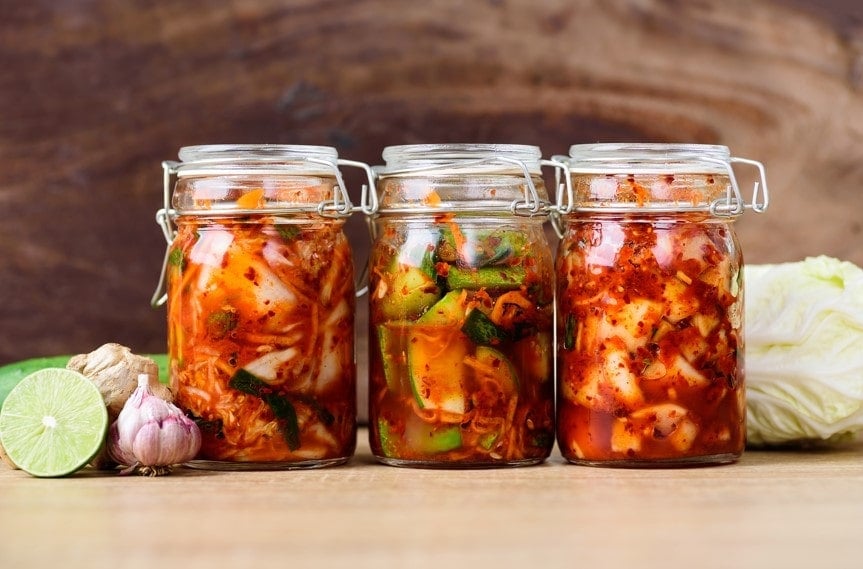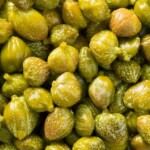This post may contain affiliate sales links. Please read my disclosure policy.
One of the most famous things about Korea is definitely its exquisite cuisine. From bibimbap through bulgogi to Korean beef or fried chicken, they are all so delicious and hard to forget.
However, there is one dish that has a special place in the hearts of many Koreans – kimchi. It can be eaten on its own, as a side dish, as a condiment, or in many other ways. But what is kimchi, and how does it taste? Let me explain that to you in more detail!

What Is Kimchi Made From?
There are numerous recipes for kimchi, as Korean families tend to modify the standard version and add their favorite ingredients. Nonetheless, they are mostly similar in a way and include some of the most basic ingredients, such as cabbage.
This vegetable is extremely popular in Asian cuisine (you can also try my Chinese cabbage salad, for example). For traditional kimchi, it’s best to use baechu, also referred to as napa cabbage. It’s cut into quarters lengthwise and then salted or brined. In this way, the excess water can be drawn out, making the cabbage last longer.
Even though kimchi does not necessarily have to be spicy, in most traditional recipes, you will find gochugaru (Korean chili flakes) or, alternatively, gochujang (a chili paste).
The chili should be blended into a paste with ginger, garlic, and usually, a bit of rice flour mixed with water. What’s more, it is a common practice to add fish sauce or salted preserved shrimp to bring a savory “umami” flavor and support the fermentation process. There is also a vegan version – in this case, you can leave out these ingredients or use miso instead of them.
On top of that, it is good to add thinly sliced vegetables, such as carrots, radishes, or scallions, to the paste and leave them to infuse for some time. Then, the mixture should be rubbed onto the drained cabbage leaves.
The final step is to pack the coated cabbage tightly into a jar or a different airtight container. It happens people also add some leftover cabbage juices to cover all the kimchi. However, it’s crucial to spare some space in the container for the carbon dioxide that will appear as a result of the fermentation process. Kimchi can be consumed even after one day, but it tastes best after a week.

The History of Kimchi
The tradition of making kimchi has a long history, as it started over 3,000 years ago. At that time, Korean people began to ferment vegetables to preserve them for the cold winter and protect themselves from dying of starvation. In the times prior to refrigerators, pickling was one of the best methods to prolong the lifespan of food.
Interestingly, at first, kimchi was not a spicy dish because the early records don’t mention chili or garlic in the recipes. Chili peppers were a New World crop, brought from the Americas and introduced to East Asia by Portuguese traders.
The first mentions of kimchi with this ingredient come from the 17th or 18th century, and it was not widespread until the 19th century. The recipes from the early 19th century strongly resemble kimchi in the present form.
What Does Kimchi Taste Like?
Kimchi is famous for its rich and complex flavors. It’s worth noting that despite becoming a bit softer in the fermentation process, the vegetables stay crunchy. Moreover, they gain a pleasant acidity, providing a nice fresh taste in the mouth.
Also, as I already mentioned, modern kimchi usually contains the Korean chili (gochugaru) pepper, qualified as medium hot, with a delicate, fruity, and a bit smoky flavor. Combined with other ingredients like ginger, garlic, or fish sauce, it’s a spicy and fragrant condiment – almost impossible to resist!
What Are the Health Benefits of Kimchi?
Kimchi is well-known not only for its outstanding taste but also for its excellent health benefits. Here are some of the most significant ones:
Rich in Probiotics
The lacto-fermentation process is a crucial part of making kimchi – and it makes it truly special. Namely, apart from extended shelf life and improved taste and aroma, it makes the food rich in probiotics.
The friendly bacteria can thrive and multiply and may improve your gastrointestinal health, boost your immune system, ease your skin conditions, be helpful with your heart issues, and more. It can also help with the common cold, so don’t forget about it next time you start to sneeze!
Low in Calories While Rich in Fiber
Kimchi is full of vegetables that are rich in fiber and nutrients. Thanks to the fermentation process, all the benefits of vegetables are preserved – and even improved, as some bacteria synthesize new nutrients, including vitamins B and C.
On top of that, the carbohydrate content naturally present in those vegetables is consumed by bacteria, which makes kimchi low in calories and high in fibre.
The Drawback of Kimchi
Despite all the health benefits of kimchi, there is one important drawback that should be taken into consideration. Namely, this fermented condiment contains quite a lot of sodium and garlic that may not be recommended (at least not every day) for people struggling with irritable bowel syndrome or at risk of high blood pressure and heart issues.
How to Cook Kimchi?
Kimchi tastes great on its own or as a side dish, but there are also many ways to add it to various recipes to make the food more delicious! Some of the dishes with kimchi are as follows:
- Bibimbap – a famous comfort food served in a bowl. It can include meat, rice, and vegetables, and be topped with an egg. Fresh and sour kimchi makes it even more irresistible!
- Kimchi Mandu – dumplings containing chicken, pork, or beef mixed with finely chopped kimchi.
- Kimchi Jjigae – a delicious and comforting soup, with meat, tofu, vegetables, noodles, etc. Kimchi provides the broth with an amazing kick!
- Kimchi Buchimgae – baked crispy pancakes with kimchi mixed into the batter, similar to latkes.
The Bottom Line
Overall, kimchi is a tasty fermented side dish or condiment that is rich in nutrients and low in calories. It’s been appreciated by Koreans for thousands of years, and nowadays, it is amazingly popular worldwide.

Unless you have IBS or cardiovascular problems, you can consume kimchi often and enjoy its unique flavor and aroma. It goes well with many Asian dishes, such as dumplings or bibimbap, so you can add it to improve your next Korean lunch. When you try it, you will know why it is loved so much in Korea and not only!




